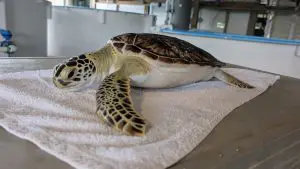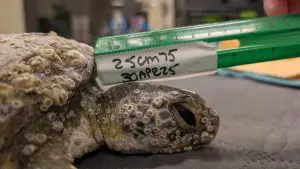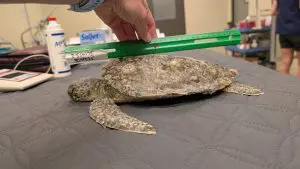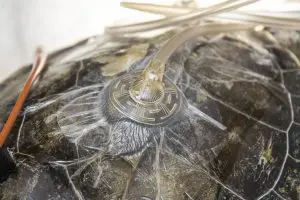

Meet Bugs!
It’s been a long, winding journey for Bugs, a juvenile green sea turtle who arrived at our Sea Turtle Healing Center in late April. But now, the little one is finally returning to their home in the ocean!
Bugs will be released at 10 a.m. on Wednesday, October 1 from Pelican Beach Park, 1525 Highway A1A in Satellite Beach. Flippers will be in the water at 10 a.m.! While we release sea turtles rain or shine, releases can be delayed or cancelled if there is lightning in the area.
When our partners at the Sea Turtle Preservation Society found Bugs washed ashore at Satellite Beach, the emaciated turtle was brought straight to our Zoo for a full examination.

Can you believe Bugs’ transformation?
The tiny turtle’s body was laden with barnacles, with some burrowing so deep into their carapace that multiple fractures were created all along their shell. These fractures exposed their scapula, causing its underlying tissue to die and leaving deep pockets to build up with material inside the wound, said Jess Patterson, our Sea Turtle Healing Center coordinator.
Though Bugs was lucky to have been found before their injuries progressed, the depth of the fracture meant that this turtle had a lengthy rehabilitation ahead.

Upon their arrival, Bugs only weighed a little over 3 pounds. Now they’re nearly 7 pounds!
First, we placed the turtle in a custom-made shallow pool to take the load off their frail body. Our team worked diligently to help Bugs eat, slowly improving their hydration and appetite. Bugs was also set up with negative-pressure wound therapy, an innovative type of treatment we provide to our turtle patients.

Negative-pressure wound therapy is also known as “wound vac therapy” (photo is of a now-released patient named LJ)
Through this process, a suction-like device is placed over a wound to reduce swelling and extract fluids from the wounded area, encouraging blood flow and new skin cell growth.
Every three days, our veterinary staff thoroughly cleaned and re-examined Bugs’ wound to keep the site clean and clear of infection as it healed. It was a meticulous, precise process, but our hard work paid off! After a month of wound-vac therapy, Bugs’ wound was free of dead tissue and bone.
Our team also equipped the turtle with plenty of antibiotics and regularly performed CT scans and radiographs to monitor the healing of the scapula and carapace injuries.
For an extra healing boost, our Healing Center staff also packed raw, unfiltered honey into some of the open wounds, promoting further healing while keeping infection out!
Now, five months later, Bugs is ready to return home!
As a keystone species in their ecosystems, sea turtles are a vital part of our Floridian wildlife. Our Zoo is continuously proud to provide life-saving care for these beautiful marine creatures across the state, one turtle at a time! Special thanks to the Felburn Foundation for their generous support of the Sea Turtle Healing Center.
Have you found a sea turtle that needs help? Visit this page or call the Sea Turtle Preservation Society at 321-206-0646. Want to help the Sea Turtle Healing Center? Support our Zoo, or view our Healing Center’s wishlist.